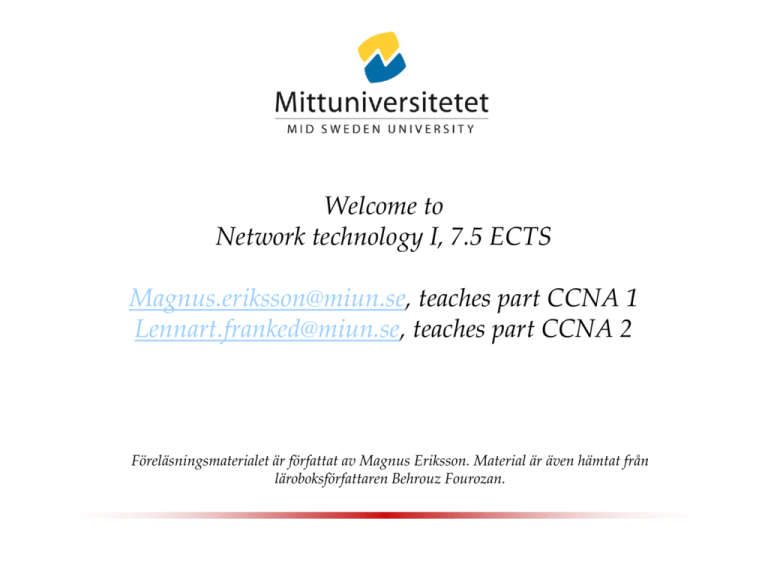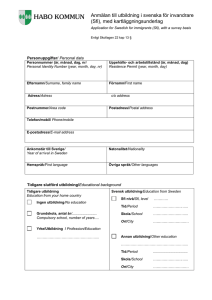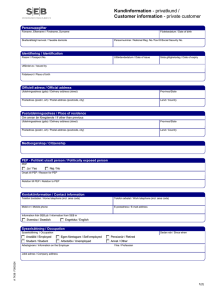CCNA 2
advertisement

Welcome to Network technology I, 7.5 ECTS Magnus.eriksson@miun.se, teaches part CCNA 1 Lennart.franked@miun.se, teaches part CCNA 2 Föreläsningsmaterialet är författat av Magnus Eriksson. Material är även hämtat från läroboksförfattaren Behrouz Fourozan. 2 Network Technology I This course presents fundamental concepts of computer networks. You get practical experience of commands for troubleshooting and configuration of switches and routers. The course content corresponds to CCNA Exploration part 1 (Network fundamentals) and 2 (Routing protocols and concepts). Together with Network Technologies II (i.e. CCNA part 3 and 4) this course facilitates makes you eligible to Cisco Academy’s CCNA certification at an external certifier. Cisco CCNA certification Network technology I, 7.5 hp: Cisco Academy CCNA 1 (Network fundamentals). CCNA 2 (Routing). Require CCNA 1. Network technology II, 7.5 hp CCNA 3. Requires CCNA 1 and 2. CCNA 4. Requires CCNA 1, 2 and 3. Offered in period 4 After that you are eligible for CCNA certification at some commercial education company. 4 Course organization Each subcourse (e.g. CCNA 1 and CCNA 2 respectivel) consists of: About 10 chapter self-tests. About 10 chapter tests (assessments), Rekommendation: 70% correct on each test! A practice final assessment. 70% required before you can take the final exam. A supervised final exam in Sundsvall. 70% required for passing. lab exercises. (CCNA 1: Lab 1.1, 1.2. CCNA 2: Lab 2. In Moodle) feedback form. Must be filled in before you can be registered on next subcourse. Each test and exam takes between 75 and 90 minutes, and consists of multiple choice questions. You will have problems if you only learn the answers by heart. You must also understand them, otherwize it will be impossible for you to pass the last labs. 5 Register At student portal as well as http://cisco.netacad.net. See Moodle for more information. 6 Amount of information - - Think about a number between 0 and 15. I am now going to guess it using as few yes and no questions as possible. I start by asking: Is the number larger than or equal to 8? Yes Is it larger than or equal to 12? (The interval is successively divided by 2.) No. Is the number larger than or equal to 10? Yes Is the number larger than or equal to 9? Yes. The amount of information you give me when you tell me that the number is 9 is 4 bits, because the amount of information in bits is the minimum number of yes and no questions that are required. We had 16 options, which is = 24 = 2·2·2·2, corresponding to 4 bits. If the number of options was 32 = 25 , it would require 5 bits. If yes is represented by the binary digit ”1”, and no by ”0”, the value in the above example can be represented by 1 0 1 1. 7 Bits and Bytes N bit can represent M=2N different values. M values can be represented by N = 2log M =log M / log 2 values Example: The N=7 bit ASCII character code consists of M=128 codes. 8 bits = 1 byte (a unit for measuring amount of data) 1 kbit = 1000 bit (previously 1024 bit). 1 Mbit = 1000 kbit (previously 1024 kbit). 1 Gbit = 1000 Mbit. 1 Tbit = 1000 Gbit. 8 Range of data communication techniques 0.1 m 1m 10 m 100 m 1 km Circuit board Example: EISA System Room Serial/parallel ports Personal Area Networks (PAN) Building Campus Local area Networks (LAN) 10 km 100 km City Country 1000 km Continent 10,000 km I/O bus Planet Example: RS232 (”com port”), USB, Firewire, Bluetooth, IEEE 802.15 WPAN Example: Ethernet, IEEE 802.11 WLAN Metropolitan Area Networks (MAN) Example: Ethernet, ATM, FDDI, IEEE 802.16 Wide Area Networks (WAN) Example: The Internet. The Public Service Telephone Network (PSTN) 9 Figure 2.17 The OSI seven layer model 10 The Layers of OSI Model End System R Application Presentation Intermediate System Application Presentation Session Session Transport Network Transport Network Data Link Physical Network Data Link Physical Data Link Physical 11 Summary of OSI Layer Functions Application To translate, encrypt and compress data Presentation Session To provide reliable end-toend message delivery and error recovery To organize bits into frames, to provide nodeto-node delivery To allow access to network resources Transport Network Data Link Physical To establish, manage and terminate sessions To move packets from source to destination; to provide internetworking To transmit bits over a medium; to provide mechanical and electrical specifications 12 Figure 2.2 The TCP/IP five layer model Example protocols: HTTP, SMTP, FTP, Telnet TCP, UDP IP Ethernet, PPP over modems Only four layers in Cisco literature! Layer 1 and 2 are merged to a ”Network access layer” or ”Link layer”. The network layer is called Internet layer. 13 Figure 2.4 An exchange using the Internet model H – header (pakethuvud): control data added at the front end of the data unit T – trailer (svans): control data added at the back end of the data unit Trailers are usually added only at layer 2. 14 Figure 2.3 Peer-to-peer processes Protocol N on device A and on B are peers (”varandras likar”). 15 Adresses to my computer Physical MAC address, 48 bits: 00-00-E2-4F-54-04 Public IP address, 32 bitar: 193.10.250.187. Private NAT IP address (Network Address Translation): 10.14.1.63. IP subnet mask: 255.255.0.0 DNS name (Domain namn Service): mageripc.itm.miun.se, där itm.miun.se is DNS suffix, and .se top domainn. URL to web page at web server at my computer: http://mageripc.itm.miun.se:portnummer/filkatalog/filnamn.typ Port number is default 80. Many computers in the world has DNS alias ”www”. URL to ftp file at my computer: ftp://användanamn:lösenord@mageripc.itm.miun.se/filkatalog/filnamn.typ Windows file name for file if shared disk access of my computer: \\mageripc.itm.miun.se\directory\filename.type . E-mail address to user at an e-mail server at my computer: användarnamn@mageripc.itm.miun.se 16 Systems and protocols for address translation ARP (Address resolution protocol) transaltes IP address to physical address. DHCP (Dynamic Host Configuration Protocol) might give every computer a free IP address. DNS (Domain Name Server) translates IP address to/from DNS name. NAT (Network Address Translation) is a proxy server, often part of the network firewall, that modifies IP packet by replaceing the private source IP address and port number by its public IP address and port number, and vice versa when receiving data. Thus several computers can share one IP address. 17 Figure 2.5 Physical layer 18 Note: The physical layer is responsible for transmitting individual bits from one node to the next. Example: RS232 (the serial “com” port) 19 Lager 1 Physical layer duties: •Contacts •Electrical levels •Modulation (Passband transmission) •Pulse coding (Baseband transmission) •Multiplexing •Bit synchronization •Circuit switching Example: RS232 (“com”-porten) 20 Figure 2.6 Data link layer/Network access layer 21 Note: The data link layer is responsible for transmitting frames from one node to the next. 22 Lager 2 Datalänklagret är protokoll för transmission av ramar (frames) från en nod till nästa. Detta kan innefatta: •Fleraccessprotokoll (multiple access control=MAC) för att undvika kollisioner •Adressering inom LAN:et/länken (nätverkskortens fysiska MAC-adresser eller nivå 2-adress). •Felhantering (t.ex. vid trådlös kommunikation eller telefonnätsmodem) Exempel: Ethernet ligger på lager 1 och 2. 23 Figure 2.7 Node-to-node delivery 24 Figure 2.8 Example 1 I Figure 2.8 sänder en nod med fysisk adress 10 en ram (dvs ett paket på nivå 2) till en nod med fysisk adress 87. De två noderna är förbundna med en länk. Ramens huvud (header H2) innehåller bl.a. avsändarens och mottagarens fysiska adress. Ibland används en svans (trailer T2) som innehåller felrättande och/eller 25 felupptäckande kod. Example 1 In Figure 2.8 a node with physical address 10 sends a frame to a node with physical address 87. The two nodes are connected by a link. At the data link level this frame contains physical addresses in the header. These are the only addresses needed. The rest of the header contains other information needed at this level. The trailer usually contains extra bits needed for error detection 26 Figure 2.9 Network layer/Internet layer/Internetwork layer 27 Note: The network layer is responsible for the delivery of packets from the original source to the final destination. 28 Lager 3 Nätverkslagret ansvarar för vidareförmedling av paket “end-to-end”, dvs via kedjan av datalänkar från den ursprungliga källan till den slutliga destinationen. Detta innefattar WANadressering (t.ex. IP-adresser) och routingprotokoll. Exempel: IP-protokollet. 29 Figure 2.10 Source-to-destination delivery 30 Figure 2.11 Example 2 I figur 2.11 vill vi sända data från en nod med logisk nätverksadress (IP-adress) A och fysisk adress 10 till en nod med IP-adress P och fysisk adress 95. De två enheterna befinner sig i olika LAN. Därför kan vi inte enbart använda deras fysiska adress. Den fysiska adressen kan enbart användas vid kommunikation inom ett LAN. De två routrarna förstår av IPadressen vilken väg paketen ska vidareförmedlas, och ändrar paketets fysiska adressering. 31 Illustration of the Source-to-end Delivery at the Network Layer Observe how data are sent from node to node to reach the final destination. Animation of Figure 2.11 in the book 32 Figure 2.12 Transport layer 33 Note: The transport layer is responsible for delivery of a message from one process to another. 34 Figure 2.12 Reliable process-to-process delivery of a message 35 Figure 2.14 Example 3 36 Example 3 Figur 2.14 exemplifierar transportlagret (UDPprotokollet). Data som kommer från högre lager förses med en TCP-header, som innehåller portnummer j och k. Avsändarprocessens portnummer är j och mottagarprocessens portnummer är k. Eftersom meddelandets storlek är större än nätverkslagret kan hantera, delas datat i två segment (två paket). Nätverkslagret lägger till nätverksadresserna (A och P) till varje paket. 37 Lager 4 Transportlagret ansvarar för leverans av meddelanden “end-to-end”, från en process på avsändardatorn till en process på mottagardatorn. Detta kan innefatta: •portnummer, •virtuell kretskoppling, dvs flödesstyrning, felkontroll, segmentnumrering, omsändning, ordning av segment. (TCP-protokollet. Ej UDPprotokollet.) 38 Figure 2.15 Application layer 39 Note: The application layer is responsible for providing services to the user. 40 Lager 5: Applikationslagret är kommunikationsprotokoll för att tillhandahålla en komplett kommunikationstjänst till slutanvändaren. Exempel: •HTTP för web •Telnet för terminalemulering. •FTP för filöverföring. •SMTP, POP3 och IMAP4 för Internet e-post 41 Figure 2.16 Summary of duties 42 Bandbredd kan betyda många saker Analog bandbredd i Hertz. Övre gränsfrekvens minus undre gränsfrekvens. Net bit rate = Digital bandbreddskapacitet i Bit/s. = Datatakt exklusive felupptäckande koder. Net bit rate ≤ Gross bit rate Maximal genomströmninshastighet = Maximal throughput Genomströmningshastighet = Throughput = Digital bandbreddskonsumtion Goodput = Filöverföringshastighet 43


